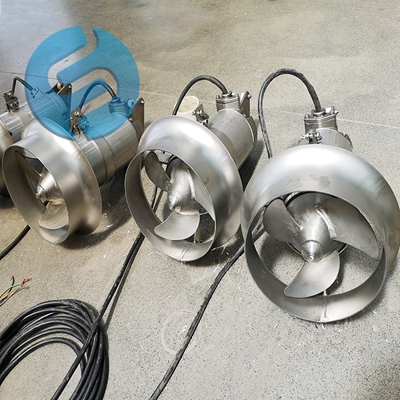The setting of mixing time of sewage mixer is a process that is comprehensively considered according to many factors such as specific treatment needs, sewage properties and equipment performance. Here are some factors and steps to consider when setting the mixing time:

First, consider the factors
1. Nature of sewage:
- Different types of sewage have different physical and chemical properties, such as sludge settling performance, suspended matter content, organic matter concentration, etc., which will affect the setting of mixing time.
- For sewage with higher organic content and more suspended matter, longer stirring time may be required to promote mixing and reaction.
2. Processing requirements:
- Depending on the different stages and purposes of the wastewater treatment process (such as mixing, flocculation, precipitation, etc.), the need for mixing time will also vary.
- For example, in the mixing stage, the stirring time is usually short and is designed to mix sewage and pharmaceutical agents quickly and violently; In the flocculation stage, the stirring time may be relatively long to promote the formation and growth of floc.
3. Equipment performance:
- The type of mixer (such as vertical, horizontal), power, speed, etc., will affect its mixing effect and time.
- When setting the mixing time, it is necessary to consider the actual performance of the equipment to ensure that the mixing effect meets the processing requirements.
Second, set the steps
1. Refer to empirical data:
- The empirical data of stirring time under similar treatment processes and sewage properties can be referred to as the basis for preliminary setting.
2. Conduct a small or pilot test:
- Before the actual operation, the treatment effect under different mixing times can be tested through small or pilot tests to determine the best mixing time.
- During the test process, the mixing time can be gradually adjusted and the trend of the treatment effect can be observed.
3. Combined with the operation effect adjustment:
- In the actual operation process, the mixing time needs to be adjusted in time according to the change of the treatment effect.
- If it is found that the treatment effect is not ideal (such as high turbidity of the effluent and low removal rate of suspended matter), the stirring time can be appropriately extended; If the treatment effect has met the requirements and too long mixing time will increase energy consumption and wear equipment, the mixing time can be appropriately shortened.
Third, specific suggestions
- For the mixing stage, the stirring time is usually short and can be set between a few seconds and a few minutes, depending on the mixing effect of the sewage and the agent.
- For the flocculation stage, the stirring time is relatively long, generally set between a few minutes to tens of minutes, depending on the formation and growth of the floc.
- When setting the mixing time, it is also necessary to consider the intermittent operation mode of the mixer (such as segmented mixing, continuous mixing, etc.), as well as the collaborative work with other processing equipment.
It should be noted that due to the differences in the nature of sewage, treatment process and equipment performance of different sewage treatment plants, the setting of mixing time needs to be adjusted and optimized according to the actual situation. At the same time, with the continuous development and progress of sewage treatment technology, the setting method of mixing time may also be constantly updated and improved.
Post time:2024-07-15